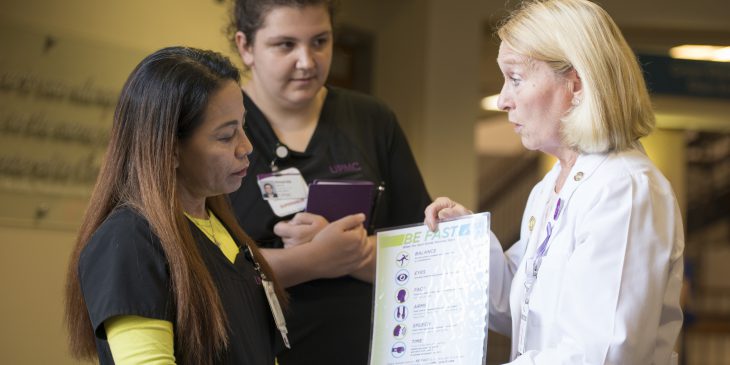With every position at UPMC, there is always an opportunity to learn the signs of stroke and help save a life.
Eleven years ago, Elvie Nairn, environmental services (EVS), UPMC Mercy, started her journey at UPMC. Little did she know her job would help save her mother’s life.
One night, Nairn was getting off work when her sister, who lives in the Philippines with their mother, called her via video to chat, which wasn’t out of the ordinary because they talked frequently. However, Nairn’s sister mentioned that their mother wasn’t feeling right. She was complaining of a headache; her left eye was swollen and she felt numb. Nairn immediately asked her sister to turn the camera around so she could see their mother.
“I told my sister that she needed to take our mother to the hospital right away because she was having a stroke,” Nairn said.
Her fears were correct. Her mother was having a mild stroke.
“That’s why I love working in the hospital. I have learned so much. In EVS, not only are you cleaning, you’re also observing your surroundings,” Nairn said. “It’s nice to work with and talk to nurses, too. Sometimes I ask the nurses about medical issues, and they’ll tell me what’s going on or how to tell when someone needs help”.
By knowing the signs and acting FAST —Face drooping, Arm weakness, Speech difficulty and Time to call 911 — Nairn was able to get quick aid to her mother – even over a Facetime call.
Providing Guidance on Stroke
Kathleen Seiler, stroke coordinator, UPMC Mercy, stresses the importance of knowing FAST and the warning signs. “About 80% of the time, when someone comes in with symptoms of speech difficulty, numbness and headaches, it’s because they are having a stroke,” Seiler said. “The quicker someone is able to identify stroke symptoms, the faster we are able to provide them with the care they need. Remember to always think FAST, and to call 911 immediately.”
With the support of UPMC, Seiler and her colleagues host educational events every other Saturday to educate the community about stroke symptoms, signs and prevention. The classes even gear some of their material toward helping children recognize a stroke. Seiler gives out coloring books that include stroke symptoms so that children can become familiar with the signs while doing a fun activity.
“Children really understand and can pick up on when something is wrong with their parent or grandparent,” she said. “These coloring books help assist with determining why grandma isn’t talking right or feels ill.”
UPMC and Our Communities
Stroke is the fifth leading cause of death for Americans and is responsible for one out of 20 deaths. At UPMC, stroke care is one of the leading health initiatives identified in the most recent Community Health Needs Assessment (CHNA).
UPMC Mercy is working to improve stroke prevention and awareness of early warning signs in the community. The hospital has offered educational programs for the public and support options for patients, including a three-day camp for stroke survivors and stroke support groups.
As a result of its clinical excellence, both in the hospital and in the community, UPMC Mercy is a certified Comprehensive Stroke Center and has earned the American Heart Association and American Stroke Association’s Gold Plus and Target Stroke Honor Roll Elite Award.
Additionally, UPMC Hamot and UPMC Presbyterian are also Comprehensive Stroke Centers, and UPMC Altoona, UPMC East, UPMC McKeesport, UPMC Northwest, UPMC Passavant and UPMC Shadyside are Primary Stroke Centers.
Learn How to Think FAST
You don’t have to work in the emergency room to learn to recognize the signs and symptoms of a stroke. Visit the UPMC Stroke Institute to learn how you can be prepared to help a stroke patient in a time of crisis.








